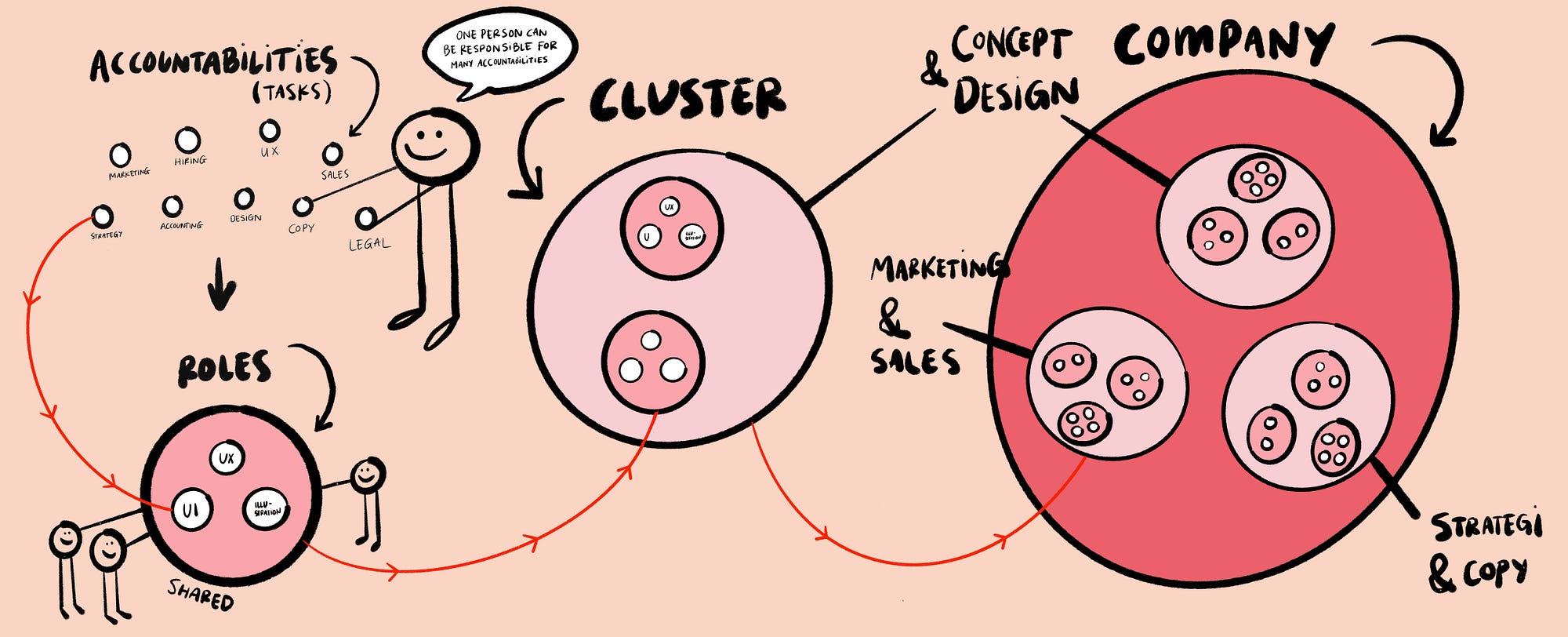
No job titles. No hierarchy. No managers. Can this be real? Yes, in fact, it even has a name: holacracy. Sounds dreamy, right? We promise it can work, as it’s actually what we use here at Serious Business! It may be difficult to wrap your head around due to the fact that the most common structure found in the business landscape today is a traditional hierarchy, where there are siloed teams, distinct management titles, and clear authority roles. If you have experience working for a large corporation, you most likely are familiar with this structure and its drawbacks. Lost communication, inefficiencies, lack of cohesive decision making, the list goes on. If you’re already well versed in holacratic structures, read our article on our biggest insights gained while adopting a holacracy. As for the rest, let’s stick to what this magical structure is all about…
Let’s get into the juicy bit. What you really came here for — holacracy. To begin, holacracy’s main objective is to ensure decision making is distributed (‘the more brains at work, the better’ kind of mentality) and to allow everyone to capitalize on their individual strengths.
Key elements regarding holacracy to keep in mind:
- A constitution or list of rules need to be established and shared amongst all employees
- Autonomy over micromanaging
- An established meeting process, to ensure communication is open and consistent
Companies who have adopted holacracies:
Let’s take a closer look at Zappos…

A key element of holacracy mentioned by Zappos is the commitment to self-management or self-organization. In order for holacracy to work properly, the entire company needs to commit to improving things, “beyond what is required of [the employee]”. What drives this self-management is the fact that employees are encouraged to find a way they believe works best to reach a said goal. What prevents utter chaos is the clear and constant communication of said expectations and goals. Because of this, there are still rules in place that ensure all actions are reflective of what employees, “are passionate about, good at, fulfill the purpose of the company, and [are] in the best interest of Zappos.” Additionally, Zappos does not have per se managers, but rather leaders. Leaders are responsible for holding people accountable and terminating employees when necessary. On the other hand, leaders are not the only individuals allowed to makes changes and decisions within the company, every employee at Zappos can make a decision on his or her own without the approval of a traditional manager.
Why holacracy, Zappos?
The motivating factor that drove Zappos to shift its structure from hierarchy to holacracy was to ensure Zappos could continue to foster innovation. In traditional hierarchies, employees can have a difficult time implementing innovative solutions because it takes time for them to reach top management. Often times, they never get implemented, resulting in known inefficiencies and frustrated employees. Zappos identified this potential obstacle as it experienced rapid growth. It was at this point when they made the wise decision to change to a holacracy.
To further illustrate how a holacracy works, remove the idea of “chain of command”, which are found in traditional hierarchies. Job titles also can be thrown away. Instead, everyone has roles that can change and evolve depending on the demands of the company. Employees can have several roles at once which are unrelated. For example, someone who holds a role as a copywriter can also hold a role related to office admin. Or an iOS developer can also hold a role as a content researcher. Roles are clustered into circles and within those circles, subcircles can form.
Ultimately, this gives employees the autonomy to make their own decisions. It’s a protest against the practice of having to wait for the manager’s permission, who has to get permission from their manager, and so forth. Additionally, it gives employees the freedom to take on roles that are out of the scope of their traditional job titles, which can provide a great sense of fulfillment, creativity, and independence to the employee. What does that mean in the end? Happier employees! And who doesn’t want that?
To find out more information on how your organization can shift to a holacracy, check out this book written by Brian J. Robertson, the creator of Holacracy.
